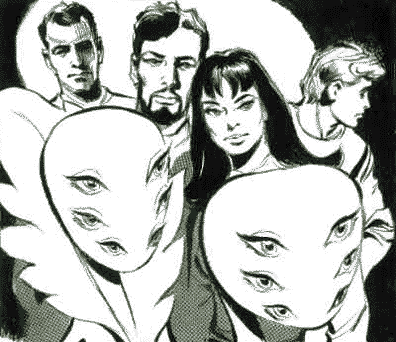


|
The Book Les Navigateurs de l'Infini [The Navigators of Infinity] is arguably Belgian writer
J.-H. Rosny Aine's science fiction masterpiece.
Originally published in France in 1925, Les Navigateurs and its sequel, Les Astronautes
[The Astronauts], written at the same
time, but published only in 1960, coined the word "astronautique" for the first time in the history of
literature. |
(1960 EDITION) COVER ART BY JEAN-CLAUDE FOREST  |

|
|
The Comic Strip Writer: Raymonde Borel-Rosny 1. Les Navigateurs de l'Infini (78 strips) These strips were reprinted in 1999 by French publisher Pressibus.  |
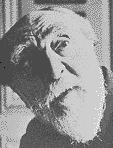 Belgian
author J.H. Rosny Aîné (1856-1940)
(pseudonym of Joseph-Henri Boex) is to French-language science fiction what H. G. Wells or Olaf Stapledon
are to English-langiuage science fiction. After Jules Verne, he is, without a doubt, the second most important
figure in the history of modern French science fiction. Rosny, who was a member of the distinguished Goncourt literary academy, was also the first writer
to straddle the line between mainstream and science fiction literature, even though his genre fiction was unjustly,
but not unsurprisingly, neglected by literary scholars. Belgian
author J.H. Rosny Aîné (1856-1940)
(pseudonym of Joseph-Henri Boex) is to French-language science fiction what H. G. Wells or Olaf Stapledon
are to English-langiuage science fiction. After Jules Verne, he is, without a doubt, the second most important
figure in the history of modern French science fiction. Rosny, who was a member of the distinguished Goncourt literary academy, was also the first writer
to straddle the line between mainstream and science fiction literature, even though his genre fiction was unjustly,
but not unsurprisingly, neglected by literary scholars. Rosny's first science fiction tale was the short story Les Xipehuz (1887), in which primitive humans (the story takes place a thousand years before Babylonian times) encounter inorganic aliens, with whom all forms of communication prove impossible. Men eventually drive away these invaders, but the hero mourns the loss of another lifeform. This was the first time that science fiction had abandoned its usual anthropomorphic approach in the description of alien life. The story Un Autre Monde [Another World] (1895) establishes that humans share the Earth with the land-bound Moedingen and the air-borne Vuren, two infinitely flat and invisible species who cohabit with us. Only a mutant whose vision was superior to that of ordinary men could see them. In Le Cataclysme [The Cataclysm] (1896), an entire region of France sees the physical laws of nature change, as a result of the arrival of a mysterious electro-magnetic entities from outer space. Rosny's short novel, La Mort de la Terre [The Death Of The Earth] (1910), takes place in the far future, when Earth has all but dried out. In it, the last descendents of mankind become aware of the emergence of a new species, the metal-based "Ferromagnetals", fated to replace us. La Mort de la Terre is one of the most moving tales ever written about the extinction of Man. One of the striking concepts of this poetic, evocative epic is that our disappearance is not the result of some kind of war or cataclysm, but merely that of natural evolution. |
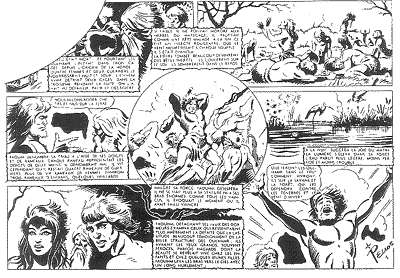
It was collected in book form by Glenat in 1976. 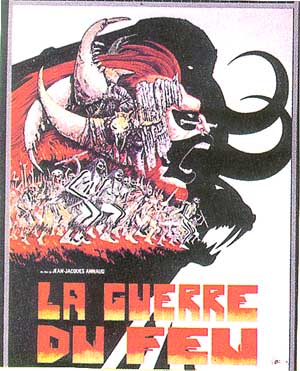 French poster for Jean-Jacques Annaud's Quest for Fire by Philippe DRUILLET |
|
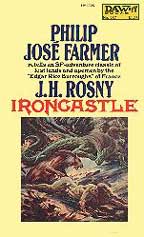 |
Another novel, La Force Mystérieuse [The Mysterious Force]
(1913), tells of the destruction of a portion of the light spectrum by a mysterious force -- possibly aliens from
outer space who, for a brief while, share our physical existence. This causes panic, then a progressive and
potentially deadly cooling of the world. Social upheaval follows, before order was restored. La Force Mystérieuse was, coincidentally, similar
to Arthur Conan Doyle's The Poisoned Sky, published at the same time. L'Énigme de Givreuse [The Enigma Of Givreuse] (1917) is another remarkable novel about the bipartition -- cloning -- of a human being into two totally similar individuals, each naturally believing himself to be the original. The novella La Jeune Vampire [The Young Vampire] (1920) is perhaps the first time that vampirism was described as a genetic mutation, transmissible by birth -- not unlike Richard Matheson's I Am Legend. L'Étonnant Voyage d'Hareton Ironcastle [The Amazing Journey Of Hareton Ironcastle] (1922) is a more traditional adventure novel, where explorers eventually discover a fragment of an alien world, with its fauna and flora, attached to Earth. It was adapted in the United States by Philip Jose Farmer in 1976. |
| Finally, Rosny
was also, if not the creator, but the author who virtually defined the sub-genre of the Prehistoric Novel and the
Lost World story in French literature. Rosny
gave nobility to the genre with five powerful classic novels: Vamireh (1892), Eyrimah (1893), the world-renowned classic La Guerre du Feu [Quest For Fire] (1909), Le Félin Géant [The Giant Cat] (1918) (sometimes known as Quest of the Dawn Man) and Helgvor du Fleuve Bleu [Helgvor of the Blue River] (1930). In these novels, he combined the notions of modern drama with the ability to depict Manís early days in a colorful, yet totally believable fashion. The dialogue between the prehistoric man and the mastodon of La Guerre du Feu is not very different from the attempts at communicating with the Xipehuz. Rosny's prehistoric novels became so popular and widely respected that La Guerre du Feu was even included in French schools' curriculum. |
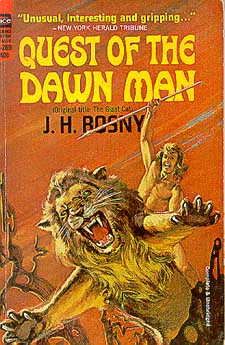 |
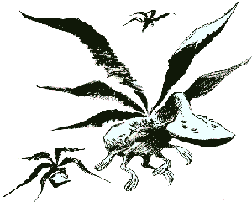 |
The Artist |